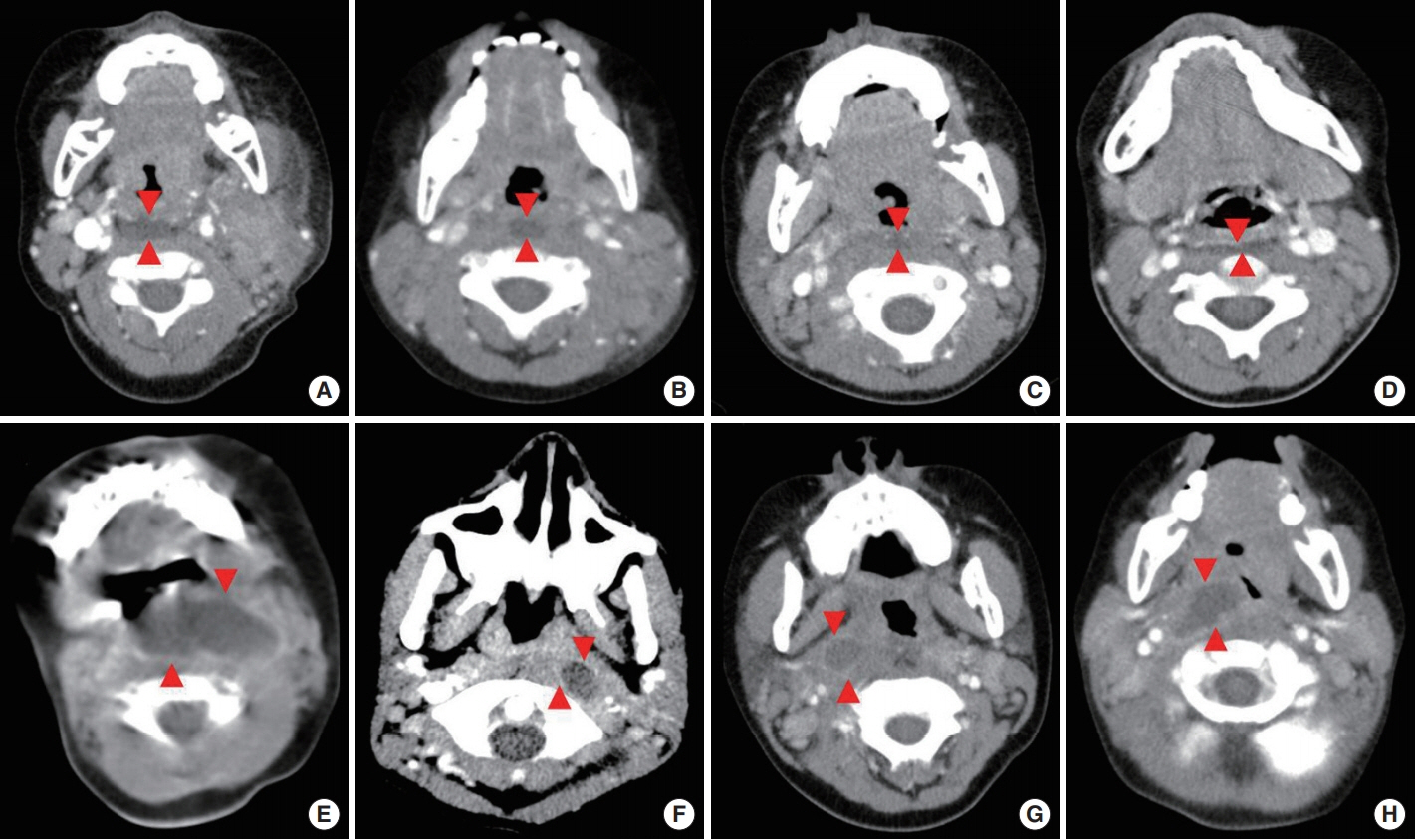Clin Exp Otorhinolaryngol.
2020 Feb;13(1):77-82. 10.21053/ceo.2019.00948.
Deep Neck Inflammation: Probable Kawasaki Disease in Korean Children
- Affiliations
-
- 1Department of Pediatrics, College of Medicine, The Catholic University of Korea, Seoul, Korea
- 2The Vaccine Bio Research Institute, College of Medicine, The Catholic University of Korea, Seoul, Korea
- KMID: 2501302
- DOI: http://doi.org/10.21053/ceo.2019.00948
Abstract
Objectives
. Deep neck infections (DNIs) can cause life-threatening complications, and prompt diagnosis and management are necessary. Kawasaki disease (KD) may be accompanied by deep neck inflammation; making it difficult to distinguish from DNIs. This study was performed to evaluate clinical features and outcomes of children with parapharyngeal and retropharyngeal inflammation.
Methods
. Medical records of the children diagnosed with parapharyngeal and retropharyngeal cellulitis or abscess using cervical computed tomography (CT) between 2013 and 2017 were retrospectively reviewed.
Results
. A total of 47 children were diagnosed with parapharyngeal and retropharyngeal inflammation. Eleven (23.4%) of them were eventually diagnosed with KD, and 36 (76.6%) were diagnosed with DNIs. There were no significantly different clinical and laboratory characteristics on admission between children diagnosed with KD and DNIs; however, significantly more children with KD were febrile for ≥3 days after admission compared to those with DNIs (P=0.009). Deep neck abscesses on CT were observed in 16 children with DNIs (44.4%) and in no child with KD (P=0.009). Among the 36 children with DNIs, 30 (83.3%) were cured with antibiotic therapy only.
Conclusion
. A quarter of children presenting with deep neck inflammation were diagnosed with KD. KD should be considered in children showing deep neck inflammation unresponsive to empirical antibiotic therapy after 3 days, especially in those presenting with deep neck cellulitis rather than deep neck abscess.
Keyword
Figure
Reference
-
1. Vieira F, Allen SM, Stocks RM, Thompson JW. Deep neck infection. Otolaryngol Clin North Am. 2008; Jun. 41(3):459–83.
Article2. Kirse DJ, Roberson DW. Surgical management of retropharyngeal space infections in children. Laryngoscope. 2001; Aug. 111(8):1413–22.
Article3. McCrindle BW, Rowley AH, Newburger JW, Burns JC, Bolger AF, Gewitz M, et al. Diagnosis, treatment, and long-term management of Kawasaki disease: a scientific statement for health professionals from the American Heart Association. Circulation. 2017; Apr. 135(17):e927–99.
Article4. Tona R, Shinohara S, Fujiwara K, Kikuchi M, Kanazawa Y, Kishimoto I, et al. Risk factors for retropharyngeal cellulitis in Kawasaki disease. Auris Nasus Larynx. 2014; Oct. 41(5):455–8.
Article5. Nomura O, Hashimoto N, Ishiguro A, Miyasaka M, Nosaka S, Oana S, et al. Comparison of patients with Kawasaki disease with retropharyngeal edema and patients with retropharyngeal abscess. Eur J Pediatr. 2014; Mar. 173(3):381–6.
Article6. Roh K, Lee SW, Yoo J. CT analysis of retropharyngeal abnormality in Kawasaki disease. Korean J Radiol. 2011; Nov-Dec. 12(6):700–7.
Article7. Kanegaye JT, Van Cott E, Tremoulet AH, Salgado A, Shimizu C, Kruk P, et al. Lymph-node-first presentation of Kawasaki disease compared with bacterial cervical adenitis and typical Kawasaki disease. J Pediatr. 2013; Jun. 162(6):1259–63.
Article8. Park BS, Bang MH, Kim SH. Imaging and clinical data distinguish lymphadenopathy-first-presenting Kawasaki disease from bacterial cervical lymphadenitis. J Cardiovasc Imaging. 2018; Dec. 26(4):238–46.
Article9. Yanagi S, Nomura Y, Masuda K, Koriyama C, Sameshima K, Eguchi T, et al. Early diagnosis of Kawasaki disease in patients with cervical lymphadenopathy. Pediatr Int. 2008; Apr. 50(2):179–83.
Article10. Katsumata N, Aoki J, Tashiro M, Taketomi-Takahashi A, Tsushima Y. Characteristics of cervical computed tomography findings in kawasaki disease: a single-center experience. J Comput Assist Tomogr. 2013; Sep-Oct. 37(5):681–5.11. Nozaki T, Morita Y, Hasegawa D, Makidono A, Yoshimoto Y, Starkey J, et al. Cervical ultrasound and computed tomography of Kawasaki disease: comparison with lymphadenitis. Pediatr Int. 2016; Nov. 58(11):1146–52.
Article12. Kim GB, Park S, Eun LY, Han JW, Lee SY, Yoon KL, et al. Epidemiology and clinical features of Kawasaki disease in South Korea, 2012-2014. Pediatr Infect Dis J. 2017; May. 36(5):482–5.
Article13. Jun WY, Ann YK, Kim JY, Son JS, Kim SJ, Yang HS, et al. Kawasaki disease with fever and cervical lymphadenopathy as the sole initial presentation. Korean Circ J. 2017; Jan. 47(1):107–14.
Article14. Page NC, Bauer EM, Lieu JE. Clinical features and treatment of retropharyngeal abscess in children. Otolaryngol Head Neck Surg. 2008; Mar. 138(3):300–6.
Article15. Meyer AC, Kimbrough TG, Finkelstein M, Sidman JD. Symptom duration and CT findings in pediatric deep neck infection. Otolaryngol Head Neck Surg. 2009; Feb. 140(2):183–6.
Article16. Cheng J, Elden L. Children with deep space neck infections: our experience with 178 children. Otolaryngol Head Neck Surg. 2013; Jun. 148(6):1037–42.17. Hoffmann C, Pierrot S, Contencin P, Morisseau-Durand MP, Manach Y, Couloigner V. Retropharyngeal infections in children. Treatment strategies and outcomes. Int J Pediatr Otorhinolaryngol. 2011; Sep. 75(9):1099–103.
Article18. Wong DK, Brown C, Mills N, Spielmann P, Neeff M. To drain or not to drain: management of pediatric deep neck abscesses: a case-control study. Int J Pediatr Otorhinolaryngol. 2012; Dec. 76(12):1810–3.19. Nagy M, Pizzuto M, Backstrom J, Brodsky L. Deep neck infections in children: a new approach to diagnosis and treatment. Laryngoscope. 1997; Dec. 107(12 Pt 1):1627–34.
Article20. McClay JE, Murray AD, Booth T. Intravenous antibiotic therapy for deep neck abscesses defined by computed tomography. Arch Otolaryngol Head Neck Surg. 2003; Nov. 129(11):1207–12.
Article21. Daya H, Lo S, Papsin BC, Zachariasova A, Murray H, Pirie J, et al. Retropharyngeal and parapharyngeal infections in children: the Toronto experience. Int J Pediatr Otorhinolaryngol. 2005; Jan. 69(1):81–6.
Article
- Full Text Links
- Actions
-
Cited
- CITED
-
- Close
- Share
- Similar articles
-
- CT Analysis of Retropharyngeal Abnormality in Kawasaki Disease
- Kawasaki Disease
- The Association of Kawasaki Disease and Coxiella burnetii
- Clinical Characteristics of Lymphadenopathy as the Initial Manifestation of Kawasaki Disease
- The Clinical Characteristics and Coronary Complication of Infantile Kawasaki Disease


